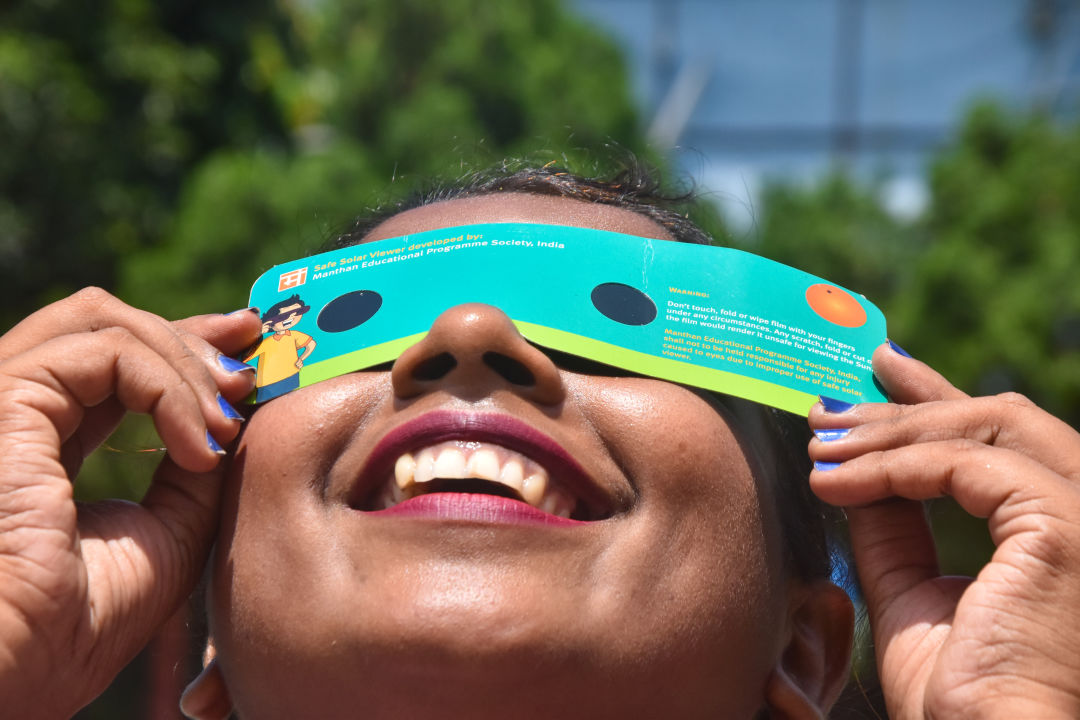Everything You Need to Know about the Annular Solar Eclipse

You can watch the annular solar eclipse (safely) at various spots in Houston.
Image: Hafiz Ahmed/Shutterstock
It’s time to get ready for a rare celestial spectacle. On October 14, an annular solar eclipse will be crossing the skies of North, Central, and South America. And great news: With an 84 percent partial eclipse path, Houston sits in a great spot to view this extraordinary event that will transform the sun into a mesmerizing ring of fire. This eclipse is expected to last from about 10:27 a.m. to 1:38 p.m., or later, in our region. Maximum coverage will occur at around 11:58 a.m. You might not want to miss this one since we will not be getting another annular eclipse until June 21, 2039—and even then, you'll have to travel to Alaska to see it.
What is an annular solar eclipse?
An annular eclipse occurs when the moon positions itself perfectly between the Earth and the sun while being at its farthest point from our planet. Unlike a total eclipse where the moon completely conceals the sun, during an annular eclipse, the moon only partially obscures the sun’s disc, creating a stunning effect. It leaves a fiery, radiant ring of sunlight encircling the moon’s darkened edges, earning it the nickname “Ring of Fire” eclipse.
Safety first
You should always wear eye protection when observing an eclipse, but unlike total solar eclipses, Saturday’s sun will not be completely blocked out, making eye safety extra important. Don’t rely on your sunglasses alone. According to NASA, you will need to use either solar viewing glasses or a handheld solar viewer. Five million pairs of eclipse glasses have been distributed to thousands of libraries across the nation for the occasion. So call your closest library to see if you can grab a pair or two before the show. Just make sure to avoid looking at the eclipse through camera lenses or regular binoculars as the rays could still cause some serious eye damage.
While it might look like the sun is losing its intensity during an eclipse, it’s a common misconception that you can skip sunscreen. In fact, the sun’s harmful UV rays are still very much present during this event, and your skin can still be damaged if not protected. So, don’t forget to apply sunscreen generously, especially if you plan to be outdoors for an extended period to witness the annular eclipse. Your skin will thank you later.
Where to see the annular solar eclipse
Participate in Space Center Houston's pop-up
NASA | 10 a.m.–3 p.m. | Free with general admission ($25 and up)
Space Center Houston will offer a one-of-a-kind way to experience the annular solar eclipse. NASA’s “Experiencing the Eclipse Through Touch and Sound” pop-up program will provide families with an opportunity to engage their senses and learn about this unusual event in the sky. There will be unobstructed viewing areas, interactive activities, and informative programming on the science of eclipses, all while ensuring safe viewing with complimentary eclipse glasses. Members of the Houston Astronomical Society will be available to assist visitors in using telescopes and building pinhole cameras, with a special presentation at 11:15 a.m.
Space Center Houston, 1601 E NASA Pkwy
Bring the family to a viewing party at Children’s Museum Houston
Museum District | 10 a.m.–2 p.m. | Free
Children’s Museum Houston is hosting an exciting solar eclipse viewing party. During the event, visitors can grab a pair of free special glasses and witness the solar phenomenon firsthand at the Allen Family Courtyard weather station. Glasses are limited, so consider bringing your own if you can, or enjoy the viewing party indoors by watching the live stream of the eclipse or exploring the fascinating science behind the eclipse’s occurrence at the science station. From understanding why the sun and moon appear the same size during an eclipse to investigating moon crater formation and crafting pinhole projector postcards, this event will be fun, educational, and interactive for all ages.
Children’s Museum Houston, 1500 Binz St
Watch the eclipse from the Houston Museum of Natural Science
Museum District | 10 a.m.–2 p.m. | Free
Head to the Houston Museum of Natural Science’s front plaza sundial for hands-on activities like creating sundials and eclipse viewers from cereal boxes. Expert astronomers will be on-site to discuss the difference between an annular solar eclipse and a total solar eclipse (happening April 8, 2024). While Houston will witness an 84 percent partial eclipse, the Burke Baker Planetarium will be livestreaming the path of annularity, also known as “ring of fire,” from Bandera, Texas, on a first-come, first-served basis.
HMNS, 5555 Hermann Park Dr




